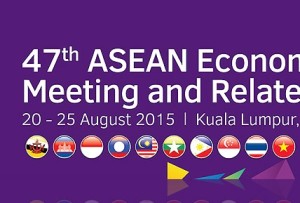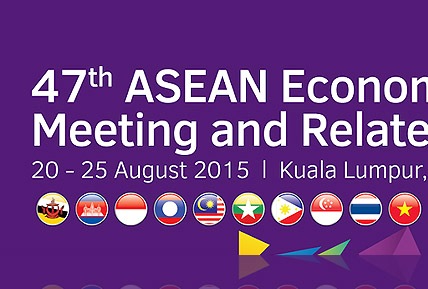 The economic ministers of the Association of Southeast Asian Nations (ASEAN) assured that their countries will not go back on their commitment to complete all agreed measures toward a cohesive, competitive ASEAN Economic Community (AEC).
The economic ministers of the Association of Southeast Asian Nations (ASEAN) assured that their countries will not go back on their commitment to complete all agreed measures toward a cohesive, competitive ASEAN Economic Community (AEC).
They made the pledge at the recent 47th ASEAN Economic Ministers’ (AEM) meeting in Kuala Lumpur, saying they will ensure that there is “no backsliding or roll-back of measures to enhance the 10-member grouping’s competitiveness” undertaken in the AEC initiative.
In the session chaired by Dato Sri Mustapa Mohamed, Malaysia’s Minister of International Trade and Industry (MITI), the ministers agreed that the immediate priority should be to complete the outstanding AEC measures by end of this year. They expressed satisfaction that over 91% of the AEC Blueprint Measures have been implemented, pending the formal establishment of the AEC by the end of this year.
“The ASEAN Economic Ministers are determined to ensure that the momentum is maintained, and highlighted several areas that can be enhanced to ensure this goal is met,” according to a MITI release. “One of the key initiatives they discussed is in the area of trade facilitation, especially the harmonising of regulations among all 10 ASEAN Member States and the issue of non-tariff barriers. “
As such, the ministers welcomed the work of the ASEAN Trade Facilitation Joint Consultative Committee and the establishment of the ASEAN Solutions and Settlements for Investments, Services and Trade, an Internet-based consultative facility enabling the private sector to lodge their complaints in a transparent and open manner.
Other initiatives on trade facilitation where work is being intensified include the ASEAN and National Single Window, ASEAN and National Trade Repository, ASEAN Wide Self-Certification, and Customs facilitation and integration.
“These initiatives underline ASEAN’s efforts in enhancing transparency and access to information regarding the regulatory environment of each ASEAN Member State and greatly facilitate doing business in the region.” Minister Mustapa said.
“They indicate clearly that ASEAN is moving in the right direction. ASEAN Governments will also work closely with the private sector and the various ASEAN business councils to address the issue of non-tariff barriers,” he added.
Import duties removal
On import duties, the ministers noted that 95.99 % of tariffs have been eliminated, except for those under the sensitive list, highly sensitive list, general exception list, and products subject to 7% flexibility provision for Cambodia, Laos, Myanmar, and Vietnam. Malaysia has met the commitments and has eliminated duties on 99.7% of the products, except for a few products such as rice, tobacco, and tropical fruits.
The ministers also discussed the integration of the services sector and the implementation of the mutual recognition arrangements (MRA) for the mobility of skilled professionals in the region. They noted the ongoing efforts to finalize the tenth and the final package of services commitments under the AEC Blueprint 2015. The ministers agreed to sign the Protocol to Implement the 10th package on the sidelines of the ASEAN Summit to be held in Kuala Lumpur in November.
The officials also welcomed the work undertaken in drafting the AEC Post-2015 Vision and strategic measures. They endorsed the draft developed by the High Level Task Force for Economic Integration and called on officials to complete the action plan for each strategic measure listed in the Post-2015 AEC document by no later than April 2016. The strategic action plans will guide officials in their work on strengthening economic integration over the next 10 years.
GDP growth forecast
The AEC seeks to establish a single market and production base in ASEAN. When fully implemented, it is expected to deepen regional economic integration by facilitating a seamless flow of trade investment. The AEC’s market liberalization measures are ultimately aimed at ensuring equitable economic growth in the region, and that ASEAN’s prosperity is shared by all of the region’s 620-million strong population.
ASEAN real GDP growth expanded 4.6 percent in 2014, and is expected to touch almost 5% this year. With the implementation of the AEC, ASEAN’s GDP is forecast to grow to US$4.7 trillion by 2020 from the current $2.5 trillion.
The region’s total merchandise trade registered modest growth of 0.8% year-on-year in 2014 or $2.53 trillion. Intra-ASEAN trade reached US$608.3 billion, which accounts for 24 % of ASEAN’s total trade. China was the next top destination for ASEAN exports ($150.4 billion or 11.6% of total), followed by EU-28 ($132.4 billion or 10.2%), the U.S. ($122.4 billion or 9.5%), and Japan ($120.2 illion or 9.3%).
In foreign direct investment (FDI), inflows to ASEAN rose from $117.7 billion in 2013 to USD136.2 billion in 2014, an increase of 15.7 percent year-on-year. The European Union remained the top source of FDI to ASEAN, accounting for about 22% of the total. Japan was the second largest, with a share of 9.8%, followed by the United States with 9.6%, and China with 6.5%. Intra-ASEAN FDI also continued to grow, reaching $24.4 billion in 2014 or around 17.9% of total inward FDI into ASEAN.





